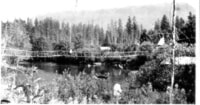For many decades, life in the community of Lake Cowichan revolved, quite literally, near and around the Riverside Inn.
Just as it is today the town core was within the view of the Riverside Inn.
The first local post office, which was located at the hotel, opened its doors to the public on Empire Day 1914 and for a few years hence, the settlement was called Riverside.
During those early years “the voice of the [hand] saw” could be easily heard throughout the settlement, as loggers and woodchoppers went about their daily tasks in the forests nearby. Logging camps and float houses dotted the lakeshore and the once pristine land and forests around Cowichan Lake would never again, be as it once was.
A national celebration, Empire Day was held on May 22. “It was the occasion of much patriotic rejoicing in the school house with Empire Days exercises being successfully held by the scholars under [their teacher], Miss Johnson’s able supervision” (Cowichan Leader notes from Kaatza Station Museum).
Children were gathered “in full force” on the school grounds where they were lectured by a Col. Haggard, on the subject of the [British] Empire. After the singing of “patriotic songs the Union Jack was raised by student Harry Beech “while the rest of the students sang the national anthem”.
The festivities continued throughout the next day with the “crowds of visitors and holiday makers dashing to and fro” from the new train station to the hotel and private residences. “Launches” (boats) laden with bright-faced, gay appareled folk flit up and down the lake”, the peaceful community suddenly transformed.
A day or two before the celebrations, one Mr. Mallory, “had caused quite a stir” at the railway station (the present day home of Kaatza Station Museum) while trying to ship his belongings to the mainland (Vancouver). It seems that amongst his belongings about to be shipped was a Hudson’s Bay musket and a “heap of bones”. Mallory and a few other men had discovered the musket and bones in a hollow stump in the Nitinat where the men had been working in the interests of the Canadian Northern Railway”.
It was believed that, the stock of the musket, which was corroded and “worm eaten”, could have lain there for forty years. There was no rational offered as to why and how long the human bones had been there and whether or not Mallory was permitted to ship out his find
There was a narrow suspension bridge, built circa 1914, crossing the river near the hotel, as well as McCallum’s bridge that spanned the mouth of the river from present day North Shore Road (where BCFP weir operations are located) to an area near the present day museum.
Both of the bridges, as limited for traffic as they were, opened the community for further settlement. Riverside Drive, which flooded for many years, was completed in 1914, while nearby streets were being planned. By now residents lived on both sides of the river with many events held at the newly finished Beech Hall, located near present day LCHS.
